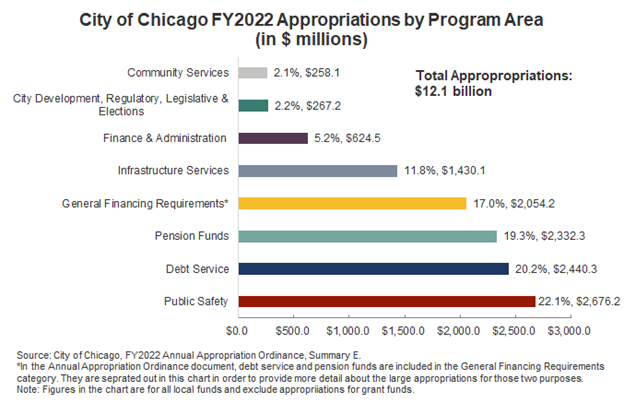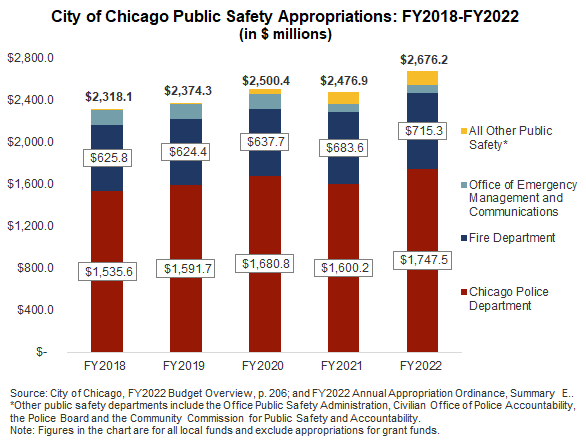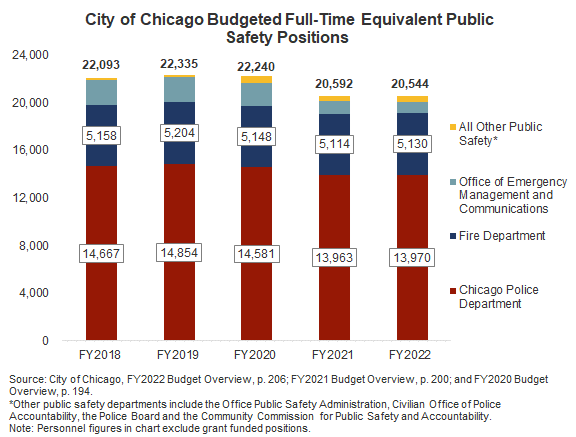December 16, 2021
The Chicago City Council approved the City’s annual budget for FY2022 (which aligns with the 2022 calendar year) on October 27. The Civic Federation supported the City’s FY2022 budget totaling $10.6 billion in an analysis of the budget proposal released earlier this fall. This blog post takes a closer look at spending in the area of public safety within the City’s budget.
Public Safety offices in City of Chicago government include the following:
- Police Department;
- Fire Department;
- Office of Emergency Management and Communications, which operates the City’s 911 call center;
- Office of Public Safety Administration, which was created in FY2020 to consolidate administrative functions including human resources, IT and finance functions of the Police Department, Fire Department and Office of Emergency Management and Communications;
- Police Board, which makes decisions in disciplinary cases involving police officers;
- Civilian Office of Police Accountability (formerly the Independent Police Review Authority), which investigates allegations of police misconduct; and
- Community Commission for Public Safety and Accountability, which is a newly created office in FY2022 to provide community oversight of the Police Department.
Together, these offices make up the public safety program area within the Chicago budget. The other program areas of the City budget are: infrastructure services; finance and administration; community services; and regulatory; legislative and elections; and city development.
The graph below shows the amount of spending the City of Chicago has approved for public safety compared to other program areas of spending in FY2022 across all local funds (excluding grant funds). Public Safety makes up the largest area of spending, accounting for nearly $2.7 billion, or 22.1% of the entire City budget in FY2022. The cost of debt service and pensions have grown significantly over the years and now represent the next two largest categories of spending after public safety. Debt costs and pensions each comprise approximately 20% of the City’s budget. Debt and pensions expenditures are included in the General Financing category of the City’s budget, but are separated out in the graph below to demonstrate the magnitude of these spending categories.
General Financing Requirements are cross-departmental expenditures such as information technology systems and employee benefits. Approximately 11.8% of the City’s appropriations are for infrastructure services such as roads and bridges, water and sewer systems and the two Chicago airports. The City spends a much smaller portion of its budget on community services and other smaller functions including city development, regulatory functions and legislative and elections.

Within the program area of public safety, total appropriations have increased from $2.3 billion in FY2018 to nearly $2.7 billion in FY2022, shown in the chart below. The figures shown are adopted rather than actual expenditures due to the budget data available in the City’s budget documents.
The Chicago Police Department makes up the largest public safety department by far, with a budget of $1.7 billion in FY2022. This represents 65% of all public safety spending. The Fire Department is the second largest public safety department, with a budget of $715.3 million in FY2022. The Fire Department represents approximately 27% of public safety spending.
The Office of Emergency Management and Communications and the remaining public safety departments account for a much smaller portion of public safety appropriations. Appropriations for the Office Public Safety Administration, Civilian Office of Police Accountability, the Police Board and the Community Commission for Public Safety and Accountability are grouped together because the budgets of these departments are so small compared to the Police and Fire Departments.

The following table provides the line-item details for appropriations in each public safety department, as well as the changes in spending within each department in the two-year period between FY2021 and FY2022 and over the five-years of budget data presented. As shown in the table, total public safety appropriations are increasing by approximately $200 million in FY2022 from the prior year. Over the five-year period from FY2018 to FY2022, however, public safety appropriations will increase by $358.1 million, or 15.4%.
The largest increase in approved spending has occurred within the Police Department. Police Department appropriations will increase by $147.3 million, or 9.2% in FY2022 compared to the FY2021 budget. The increase is primarily due to increased costs related to the collective bargaining agreement with the Fraternal Order of Police adopted in 2021.
The Office of Emergency Management and Communications budget has decreased by 45.8% between FY2018 and FY2022, largely because the City shifted approximately 900 crossing guard positions to the Chicago Public Schools budget in 2021.

Public Safety accounts for the largest portion of personnel in the City’s budget, making up 61% of the total full-time equivalent (FTE) positions across all local funds. Public Safety personnel will total 20,544 FTE positions in FY2022, which is a decrease of approximately 1,500 positions, or 7.0%, from the FY2018 budgeted personnel level of 22,093.
The Police Department accounts for 13,970 budgeted positions in FY2022. Police Department personnel positions have decreased by 697, or 4.8%, over the past five years. The majority of that decrease within CPD took place between FY2020 and FY2021 due to the department eliminating vacant positions in order to produce budget savings in FY2021. The Office of Emergency Management and Communication also has seen a significant decrease in budgeted positions—a decline of 1,176 FTEs, or 55.4% between FY2018 and FY2022—primarily due to transferring 900 crossing guard positions to the Chicago Public Schools budget in 2021.

